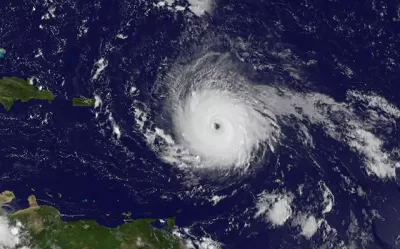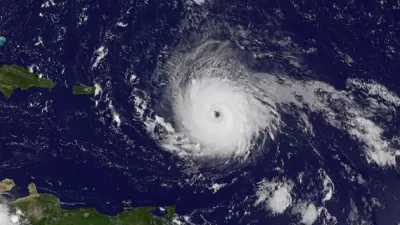As Houston and East Texas recover from Hurricane Harvey, an even stronger hurricane has formed in the Atlantic Ocean, headed to the Caribbean Sea, and likely Florida by this weekend, though there is uncertainty where it goes next.

"Hurricane Irma expanded into a 180mph 'superstorm' on Tuesday as officials warned of life-threatening winds, storm surge and rainfall in several Caribbean islands and emergency planners in Florida escalated preparations for a possible weekend strike," reports for the Guardian.
"Irma’s peak intensity so far ranks among the strongest in recorded history, exceeding the likes of Katrina, Andrew and Camille – whose winds peaked at 175 mph," report Brian McNoldy, senior research associate, University Of Miami and Jason Samenow, The Washington Post's weather editor.
First to feel the effects of Irma will be a group of Caribbean Islands known as the Leeward Islands on Tuesday, with Puerto Rico and the Virgin Islands on Wednesday. The Dominican Republic, Haiti, Cuba, and the southeastern Bahamas are also in the path of Irma.
“The chance of direct impacts from Irma later this week and this weekend is increasing in the Florida Keys and portions of the Florida peninsula,” the National Hurricane Center senior hurricane specialist Dan Brown said in his advisory.
Landfall expected in Florida Keys or South Florida by the weekend
On Monday, Gov. Rick Scott (R-Fla.) declared a state of emergency for all 67 counties in response to Irma.
"It is impossible to say with certainty whether Irma will track up along the eastern side of the Florida peninsula, the western side, or straight up the peninsula," add McNoldy and Samenow.
Beyond the weekend, the scenarios really depend on which side of Florida it tracks. But for now, it’s safe to say that the southeast United States, including the Florida panhandle, Georgia and the Carolinas, should also brace for potential impacts, such as flash flooding, storm surge and strong winds.
If Irma makes landfall as a Category 4 or higher in the United States, joining Hurricane Harvey, it will become the first time two storms so strong struck the United States in the same season.
And that's not all that's brewing in the Atlantic, warn Noldy and Samenow. " Tropical Storm Jose formed in the eastern Atlantic Tuesday morning. This storm is also predicted to intensify into a hurricane over the coming days, but the latest track keeps it away from land areas for the most part."
If you're thinking climate change must be playing a role, Samenow, The Washington Post's weather editor, explains in a perspective how climate change can exacerbate the effects of hurricane, Harvey in particular, though he doesn't mention if it affects the quantity of hurricanes, perhaps because it was published on Sept. 1. He lists them "from high confidence to low confidence:"
- By raising sea levels, climate change increased the rise in ocean water or storm surge when the storm came ashore and the coastal flooding that resulted.
- By warming temperatures in the Gulf of Mexico, climate change intensified the storm’s rainfall.
- By warming temperatures in the Gulf of Mexico, climate change intensified the storm’s peak winds.
- By slowing down the jet stream, climate change increased the likelihood the storm would stall and unload rainfall over the same areas.
His bottom line: "Climate change probably made Harvey a little worse. But you’re on shaky ground to say any less or much more."
FULL STORY: Florida prepares as Hurricane Irma grows into 180mph 'superstorm'

Planetizen Federal Action Tracker
A weekly monitor of how Trump’s orders and actions are impacting planners and planning in America.

Congressman Proposes Bill to Rename DC Metro “Trump Train”
The Make Autorail Great Again Act would withhold federal funding to the system until the Washington Metropolitan Area Transit Authority (WMATA), rebrands as the Washington Metropolitan Authority for Greater Access (WMAGA).

The Simple Legislative Tool Transforming Vacant Downtowns
In California, Michigan and Georgia, an easy win is bringing dollars — and delight — back to city centers.

The States Losing Rural Delivery Rooms at an Alarming Pace
In some states, as few as 9% of rural hospitals still deliver babies. As a result, rising pre-term births, no adequate pre-term care and harrowing close calls are a growing reality.

The Small South Asian Republic Going all in on EVs
Thanks to one simple policy change less than five years ago, 65% of new cars in this Himalayan country are now electric.

DC Backpedals on Bike Lane Protection, Swaps Barriers for Paint
Citing aesthetic concerns, the city is removing the concrete barriers and flexposts that once separated Arizona Avenue cyclists from motor vehicles.
Urban Design for Planners 1: Software Tools
This six-course series explores essential urban design concepts using open source software and equips planners with the tools they need to participate fully in the urban design process.
Planning for Universal Design
Learn the tools for implementing Universal Design in planning regulations.
Smith Gee Studio
City of Charlotte
City of Camden Redevelopment Agency
City of Astoria
Transportation Research & Education Center (TREC) at Portland State University
US High Speed Rail Association
City of Camden Redevelopment Agency
Municipality of Princeton (NJ)





























